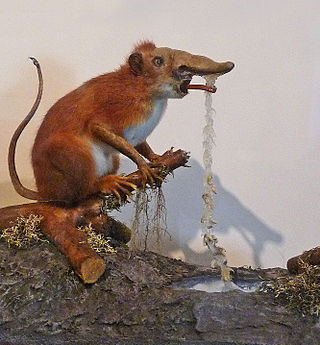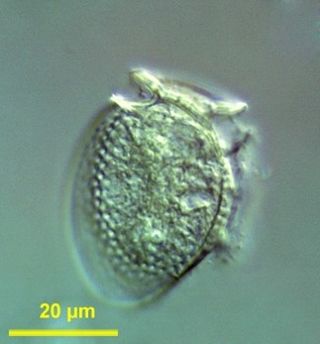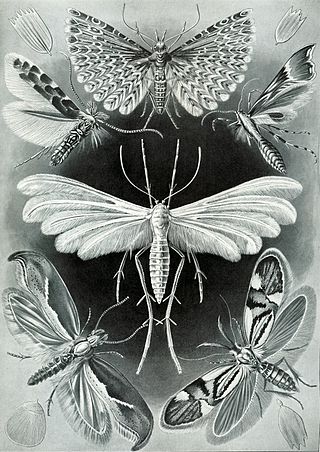
Gertrude Stein was an American novelist, poet, playwright, and art collector. Born in Allegheny, Pennsylvania, and raised in Oakland, California, Stein moved to Paris in 1903, and made France her home for the remainder of her life. She hosted a Paris salon, where the leading figures of modernism in literature and art, such as Pablo Picasso, Ernest Hemingway, F. Scott Fitzgerald, Sinclair Lewis, Ezra Pound, Sherwood Anderson and Henri Matisse, would meet.

Rhinogradentia is a fictitious order of extinct shrew-like mammals invented by German zoologist Gerolf Steiner. Members of the order, known as rhinogrades or snouters, are characterized by a nose-like feature called a "nasorium", which evolved to fulfill a wide variety of functions in different species. Steiner also created a fictional persona, naturalist Harald Stümpke, who is credited as author of the 1961 book Bau und Leben der Rhinogradentia. According to Steiner, it is the only remaining record of the animals, which were wiped out, along with all the world's Rhinogradentia researchers, when the small Pacific archipelago they inhabited sank into the ocean due to nearby atomic bomb testing.

Balantidium is a genus of ciliates. It contains the parasitic species Balantidium coli, the only known cause of balantidiasis.

Laeliinae is a Neotropical subtribe including 40 orchid genera, such as Brassavola, Laelia and Cattleya. The genus Epidendrum is the largest within this subtribe, containing about 1500 species. This is followed by the genus Encyclia, with over 120 species.

Phalanger is a genus of possums. Its members are found on New Guinea, the Maluku Islands, other nearby small islands, and Australia's Cape York Peninsula. They are marsupials of the family Phalangeridae, and are one of the four genera whose species are commonly referred to as cuscuses.

The raphidophytes, formally known as Raphidomonadea or Raphidophyceae, are a small group of eukaryotic algae that includes both marine and freshwater species. All raphidophytes are unicellular, with large cells, but no cell walls. Raphidophytes possess a pair of flagella, organised such that both originate from the same invagination. One flagellum points forwards, and is covered in hair-like mastigonemes, while the other points backwards across the cell surface, lying within a ventral groove. Raphidophytes contain numerous ellipsoid chloroplasts, which contain chlorophylls a, c1 and c2. They also make use of accessory pigments including β-carotene and diadinoxanthin. Unlike other heterokontophytes, raphidophytes do not possess the photoreceptive organelle typical of this group.
Plagiopyla is a genus of ciliates. It includes nine species:
Goniomonas is a genus of Cryptomonads and contains five species. It is a genus of single-celled eukaryotes, including both freshwater and marine species. It lacks plastids, which is very unusual among all of the Cryptophyte genera. It may reflect one of only a small number of times that the Cryptophytes evolved into freshwater habitats. Goniomonas seems to have a number of freshwater relatives which have not yet been cultured and named.
Meruidae is a family of aquatic beetles in the suborder Adephaga, with only one genus and species, Meru phyllisae. The beetle species was first found in the early 1980s. and fully described in 2005. At 0.8 mm (0.031 in), it is one of the smallest adephagan beetles in the world. A survey of aquatic beetles of Venezuela indicated that Meru is most common during the wet season, when larger areas of granitic rock surface are covered with water film, which the adult beetles as well as the larvae inhabit.

Ornithocercus is a genus of planktonic dinoflagellate that is known for its complex morphology that features considerable lists growing from its thecal plates, giving an attractive appearance. Discovered in 1883, this genus has a small number of species currently categorized but is widespread in tropical and sub-tropical oceans. The genus is marked by exosymbiotic bacteria gardens under its lists, the inter-organismal dynamics of which are a current field of research. As they reside only in warm water, the genus has been used as a proxy for climate change and has potential to be an indicator species for environmental change if found in novel environments.
Histioneis is a genus of dinoflagellates. According to the World Register of Marine Species, it contains 86 species.

Dinophysis is a genus of dinoflagellates common in tropical, temperate, coastal and oceanic waters. It was first described in 1839 by Christian Gottfried Ehrenberg.

Hoplolaimidae is a family of plant pathogenic nematodes. It has two subfamilies, Hoplolaiminae and Rotylenchulinae. Typically hoplolaimids are ecto- or semi endoparasites of higher plants.

Climacostomum is a genus of unicellular ciliates, belonging to the class Heterotrichea.
Filipodium is a genus of parasites in the phylum Apicomplexa. Species in this genus infect marine invertebrates.

Annette Frances Braun was an American entomologist and leading authority on microlepidoptera, a grouping of mostly small and nocturnal moths. Her special interest was leaf miners: moths whose larvae live and feed from within a leaf.
Scutellonema bradys, also known as yam nematode, is a migratory endoparasitic nematode causing major damage to yam crop in many African tropical regions, as well in parts of South and Central America and Asia. They can cause reduction of 20-30% in tuber weight at harvest.
Colponema is a genus of single-celled flagellates that feed on eukaryotes in aquatic environments and soil. The genus contains 6 known species and has not been thoroughly studied. Colponema has two flagella which originate just below the anterior end of the cell. One extends forwards and the other runs through a deep groove in the surface and extends backwards. Colponema is a predator that feeds on smaller flagellates using its ventral groove. Like many other alveolates, they possess trichocysts, tubular mitochondrial cristae, and alveoli. It has been recently proposed that Colponema may be the sister group to all other alveolates. The genus could help us understand the origin of alveolates and shed light on features that are ancestral to all eukaryotes.
Garrigatitan is a genus of titanosaurian dinosaur from the late Cretaceous Period of the Grès à Reptiles Formation in France. The genus contains a single species, Garrigatitan meridionalis.









